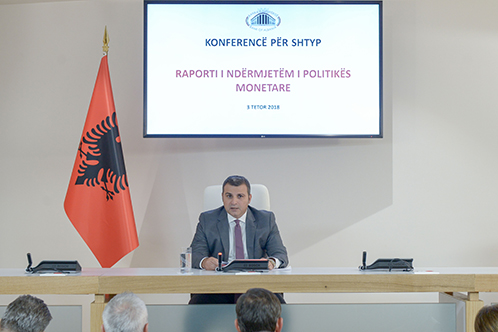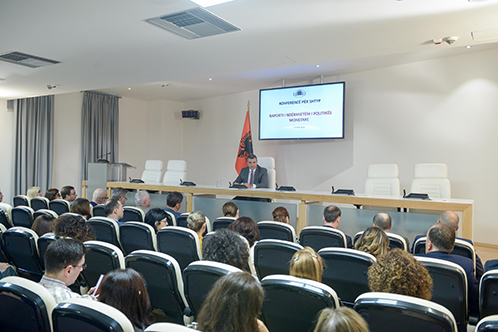BANK OF ALBANIA
PRESS RELEASE
Governor Sejko: Statement to the Press Conference on the Monetary Policy Decision of the Supervisory Council of the Bank of Albania, 3 October 2018
Publication date: 03.10.2018
Ladies and gentlemen,
In today’s meeting, 3 October 2018, the Supervisory Council of the Bank of Albania reviewed and approved the Intermediate Monetary Policy Report.
The new economic and financial information, available and analysed in today’s meeting of the Supervisory Council, is overall positive and in line with our expectations. The volume of economic activity in Albania expanded, leading to a fuller utilisation of production capacities and increase in employment and wages, and build-up of domestic inflationary pressures. The financial situation of Albanian households and firms has been improving reflected, in turn, in the improvement of their balance sheets and the constant decline in the non-performing loan ratio.
These developments continue to be sustained by the improvement in the external environment, favourable financing conditions dictated by our accommodative monetary policy stance, the foreign direct investments inflows, and the higher electricity output owing to the favourable hydro situation in this year.
The updated projections reconfirmed our previous expectations for the positive performance of the economy and for the return of inflation to target within the medium-term horizon. Moreover, the Supervisory Council deemed that, while the accommodative monetary policy stance will be necessary for guaranteeing the stability of economic growth, over the medium term, the intensity of this stimulus will be slowing down, in line with the pace of the improvement of economic activity and the speed of the return of inflation to target.

Inflation registered 2.3% and 2.2% in July and August, respectively, slightly upward from the 2.1% average registered in the first half of the year. The rise in inflation reflected the build-up of domestic inflationary pressures, the direct and indirect effects from the rise in oil prices in international markets and the high food prices. On the other hand, the appreciation of the exchange rate decelerated the imported inflationary pressures.
The Bank of Albania deems that the decelerating effect on inflation from the exchange rate appreciation will continue to be present for some quarters ahead. Yet, this decelerating factor will remain transitory and will not affect the return of inflation to target over the medium term.
Our projections suggest that inflation will converge toward our target within 2020. Such dynamics will be sustained by the continued expansion of aggregate demand, which will enable employment gains, rising wages, and higher profit margins in line with their historic rates.
According to INSTAT data, the Albanian economy grew 4.3% in the second quarter of 2018. Indirect data signal that the growth dynamic will continue in the third quarter. Economic growth was broad based, sustained by the growth in consumption and private investments, as well as the expansion of exports. On the other hand, the fiscal consolidation picked up its pace in the second and third quarters. Also, similarly to in the previous quarter, economic growth in the second quarter reflected the expansion of electrical energy output.
The economic activity expanded, leading to a fuller utilisation of production capacities. In the labour market, employment gains lowered the unemployment rate even further, to 12.4% in the second quarter. In accordance with our business activity surveys, the capacity utilisation rates hovered around 72% on average, upward from the average level recorded in the previous year. These developments sustain the strengthening and expansion of the base of domestic inflationary pressures.
Financial conditions for firms and households remain favourable, characterised by low interest rates and reduced risk premia. The financing costs of the banking sector, the private sector and the public sector are low, reflecting the accommodative monetary policy stance. The low interest rates for lek loans contributed to the expansion of the credit portfolio in the national currency, which remains the most preferred financing instrument and the main driver to the expansion of credit to the private sector. The annual growth of lek loans was 6% in August. At the end of this month, lek loans accounted for around 46.1% of total credit.
As we have previously noted, credit dynamics in Albania reflect the performance of credit demand and supply. In concrete terms, credit demand remains moderate, albeit showing an improving trend over the last quarters, whereas banks continue to apply tight credit conditions, especially for the enterprises segment. In this regard, the Bank of Albania evidences that the constant reduction of credit risk - as illustrated by the decline in the NPL ratio at 12.9% in August - creates the preconditions for banks to adopt a more proactive approach to lending.
The exchange rate remains appreciated against the currencies of our trading partners, but the appreciation trend decelerated over the summer months. Bank of Albania interventions in the foreign exchange market proved to be effective with regard to stabilising the exchange rate in the third quarter. Lastly, at the end of the touristic season, the foreign currency demand and supply appear as balanced, even in the absence of Bank of Albania interventions. Our analyses suggest that the exchange rate risk for achieving the inflation target has been diminishing.

Our expectations for the outlook are positive. The Albanian economy is expected to remain on a positive economic growth trajectory. The expansion of aggregate demand is expected to increase the degree of utilisation of production capacities, hence building up domestic inflationary pressures. In parallel, inflationary pressures from the external environment are also expected to pick up, as a result of the diminishing of the decelerating effect of the appreciated exchange rate.
In the medium term, the materialisation of this scenario requires maintaining the current macroeconomic policy mix. The accommodative monetary policy stance ensures the necessary stimulus for boosting the economic activity and for the return of inflation to our target. At the same time, the fiscal consolidation reduces the risk premia in the economy and increases the space for withstanding to potential risks.
In the long run, the acceleration of economic growth should be based on the continuation of structural reforms with regard to improving the business climate and promoting domestic and foreign investments, as well as enhancing the efficiency and expanding the potential of our economy.
Judging on the analyses and projections from the baseline scenario, the Supervisory Council deemed that the current monetary policy stance remains adequate. Taking into account these circumstances, the Supervisory Council decided to:
- Keep the policy rate unchanged, at 1.0%;
- Keep the overnight deposit and overnight lending rates, unchanged at 0.1% and 1.9%, respectively.
The Supervisory Council deems that - based on the actual trends and the available information - the normalisation of interest rates in the domestic financial market will not commence before the second quarter of 2019. In any case, this normalisation will be implemented prudently to guarantee a sustainable convergence of inflation toward the target.
The Supervisory Council deemed that the demand and supply for foreign currency appear as stable and that the exchange rate appreciation is a lower risk to inflation.

 Twitter
Twitter
 Youtube
Youtube
 Facebook
Facebook
 Flickr
Flickr
 RSS
RSS
 Subscribe
Subscribe
 Feedback
Feedback